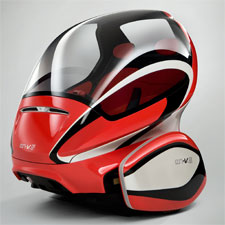|
|


ADVERTISEMENT
Buy Your own advertising
spaces!
.
Download Adobe Acrobat Reader to open [PDF] files.
Recent Visitors
GM Envisions Networked Mini Cars
2010. 24 March
 PRIDE: Working with Shanghai Automotive Industry Corp. Group (SAIC), GM designed the EN-V prototypes to meet the challenges of getting around major metropolises as urban populations swell. The vehicle's body and canopy are constructed from carbon fiber, custom tinted plastics, and acrylic, which the company says makes it light but durable.
© GM CO.
PRIDE: Working with Shanghai Automotive Industry Corp. Group (SAIC), GM designed the EN-V prototypes to meet the challenges of getting around major metropolises as urban populations swell. The vehicle's body and canopy are constructed from carbon fiber, custom tinted plastics, and acrylic, which the company says makes it light but durable.
© GM CO.
by Larry Greenemeier
(scientificamerican.com)
The automaker introduces its Electric Networked Vehicle prototypes, one third the size of a typical car, as a way to reduce big urban auto emissions and traffic congestion.
As drivers await the arrival of General Motors's much-anticipated Chevy Volt plug-in hybrid car later this year, GM unveiled an electric vehicle of an entirely different stripe on Wednesday at the World Expo 2010 in Shanghai. The company's Electric Networked Vehicle (EN-V) is a mini electric vehicle built for two, unless you are using it to go shopping, in which case you might have room for yourself and a bag of groceries.
Working with Shanghai Automotive Industry Corp. Group (SAIC), GM designed the EN-V to meet the challenges of getting around major metropolises as urban populations swell. The EN-V resembles more an enclosed pedicab—minus the bike—than it does a car. In fact, the 1.5-meter-long vehicle is three times shorter than a typical car and weighs less than 500 kilograms, one third as much as most cars on the road today.
The EN-V relies on dynamic stabilization technology similar to that of the one-person Segway scooter to keep its balance, and can be operated autonomously or under manual control. In autonomous mode the EN-V is designed to use high-speed wireless connectivity and GPS navigation to automatically select the fastest route, based on real-time traffic conditions gleaned from the Web or some other networked source of traffic information.
 Although the EN-V is currently only a concept vehicle, GM's goal is to equip them with sensors for autonomous functioning—helping drivers park and even avoid collisions. The vehicles are also expected to include systems that allow drivers to talk to other EN-V drivers while on the road. The EN-V is powered by lithium ion batteries that can last up to 40 kilometers between charges, and the vehicle is designed to be plugged into a standard wall outlet for recharging.
Although the EN-V is currently only a concept vehicle, GM's goal is to equip them with sensors for autonomous functioning—helping drivers park and even avoid collisions. The vehicles are also expected to include systems that allow drivers to talk to other EN-V drivers while on the road. The EN-V is powered by lithium ion batteries that can last up to 40 kilometers between charges, and the vehicle is designed to be plugged into a standard wall outlet for recharging.
GM also styled its EN-V prototypes—which have a top speed of 40 kilometers per hour—to appeal to urban professionals on the move. The vehicle's body and canopy are constructed from carbon fiber, custom tinted plastics, and acrylic, which the company says makes it light but durable.
By 2030, more than 60 percent of the world's population will be living in urban areas, says Chris Borroni-Bird, GM's director of advanced technology vehicle concepts. In densely populated cities around the world, including New York City, "driving is not a practical way of moving around," he says, adding that a third of city congestion is typically caused by drivers looking for parking spaces. Several cities, including Athens, México City and Bogotá, Colombia, have resorted to "road space rationing," allowing a vehicle to enter the city only on certain days (or during rush hour), based on whether its license plate number ends in an odd or even number.
Borroni-Bird compares today's cars with 1980s-era PCs, which were clunky and largely operated without any network connections. Continuing that analogy, EN-V is like the smart phones and other wireless handheld devices that today keep people connected around the clock.
The EN-V evolved from the Segway-based Personal Urban Mobility and Accessibility (PUMA) prototype that GM introduced about a year ago. PUMA weighed 136 kilograms, ran on a lithium ion battery and could travel at speeds up to 56 kilometers per hour, with a range up to 56 kilometers between recharges. The EN-V's additional weight comes courtesy of its upgraded chassis and the electronics that support the automated driving system (the PUMA did not operate autonomously). This weight, plus the more complex electronics, play a role in the EN-V's slower top speed and shorter range between charges.
Borroni-Bird acknowledges that the EN-V will be a tougher sell in U.S. cities, where a significant portion of people have grown accustomed to traversing the streets fully enclosed in weatherproof cars, trucks and buses. More likely, the EN-V will appeal more in places such as Mumbai and Shanghai, where urbanites are more used to walking and biking around their cities. "This vehicle wouldn't be as much of an outlier in other countries as it would be in the U.S.," he adds. Places like New York City might require bigger versions of the EN-V or perhaps a dedicated travel lane such as those available for cyclists.


